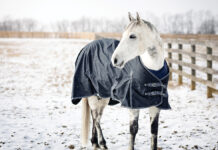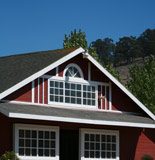Being prepared for a theft and taking steps to minimize it and maximize recovery will go a long way toward protecting your horse and getting it back.
- Permanently identify your horse with a tattoo, brand or microchip. This proves ownership, aids in a horse’s recovery and, if visible, discourages thieves.
- Take color photos of your horse, including head and full body shots (from both sides). Get photos with summer and winter coats, noting any distinguishing marks. “If the animal has just one little piece of white on his coronet band, make sure the photo is large enough to see it,” says Robin Lohnes, executive director of the American Horse Protection Association. Choose 5-by-7-inch photos, with the horse filling up about 75 percent of the photo.
- Keep photos, bills of sale, veterinary records, breed registration papers, and other documents together in an easily accessible notebook or folder.
- Know what auctions operate within a 500- to 600-mile radius of your area, their addresses, their phone and fax numbers, and when they hold sales. Says Lohnes, “You can usually find this information through the state department of agriculture or through the state veterinarian’s office.”
- Compile a list of regional USDA-inspected slaughterhouses with addresses, phone and fax numbers.
- Have available how-to publications on recovering stolen horses, such as Amelita Donald’s The Equine Recovery Handbook. Donald’s book covers what to do if a horse is stolen; a list of contacts by state, including Mexico and Canada; how to locate additional references; a list of equine slaughterhouses; sources for permanent horse identification; and prevention tips.
- Remove halters from pastured horses. It is recommended that you don’t leave them hanging near stall doors, but this is your choice to make. Many horse owners prefer to leave a halter by the horse’s stall in case of emergency, and will argue that most horse thieves come prepared with rope or halters anyway.
- Check your horse regularly, but vary your routine. “Professional thieves will watch a farm before they go onto a property,” says Lohnes.
- Install lighting with photo sensors or motion detectors around the barn or property gates, or street lights by pastures along the road.
- If possible, replace wire fencing with board fencing. “Wire fencing is easily cut. With board fencing, thieves have to find a gate,” Lohnes says.
- Keep wire fencing in good repair and as sturdy as possible.
- Use good gates, heavy chains and padlocks.
- Use thoughtful landscaping. Plant trees and shrubs between the pasture and road to block visibility of the horses from the road, but keep bushes trimmed or absent around gates and barn doors.
- Post “No Trespassing” and warning signs.
- Consider an alarm system.
- Keep dogs or loud animals around to make noise when something is amiss.
- Set up a neighborhood crime watch program.
- Observe the movements and behaviors of unfamiliar people. If they seem suspicious, report their actions to law enforcement authorities.
- If possible, videotape or photograph strangers who arrive at your barn, and record the license plates and types of vehicles. Warns Donald, “Many people casing your property may come out looking like a happy-go-lucky family with a male, female and a child or two. They may come in an old vehicle, but not necessarily a pickup, in the guise of wanting to pet or feed the pretty ponies. If you have a recorded image or license plate number, and shortly thereafter something is missing, you have a lead to provide law enforcement.
Read more horse theft prevention tips >>






Very Good Advice. Thanks for this article.
WOW..alot I never thought about..time to change some things
I don’t know what I’d do if someone stole my horse. I’d be devastated.
great info things i never really thought about
Good information, thanks.
Thanks!
Thanks for the tips
Thanks! My barn is completely invisible from the road, and you can only see my house from one part of the road, if you’re Realy looking, but I will get my two horses microchiped on the next vet visit, and record lisens plates if someone is acting even a bit suspicios. I would be devestated if one, or both of my horses were stolen. (even though I never show, and my horses are not worth millions, one of them I bought from a misstreating owner for 100 bucks) Anyways, Thanks for the info!
good advice!
Great advice!
wow great info! Hope my horse never gets stolen. These are great precautions!
Thank you for this most valuable information…it’s good to reread over and over.
Its hard to believe people are stealing horses, when others have a hard time giving them away.
my horses fence was cut twice and once they got out and found them 5 miles from home adn bc we couldnt load one right away it takes a lot of time and it was right before scool we had to hand walk 2 horses back then go get our car it was horritable and there has been people that came on our land adn was using a flashlight in our windows when we had like 7 cars out front!!!! and im just gald no 1s done that again! but i have papers on both horses and i have one regestered!!!
im so glad that this is here!!!!! thanks!!!!!!
Great tips- it’s a scary thought that your horses could be stolen!
Thanks for the tips. It makes me shiver every time I think of one of my barn’s horses being stolen!
This is a great list to be printed out and posted at the barn! Thank you for the wonderful advice!
I really like this artical because where I live now in Arco,ID a NINE year old kid broke into my aunts house where we live and STOLE THREE GUNS in broad daylight and 24 pens of Insulin which is used for diabetes which my aunt has